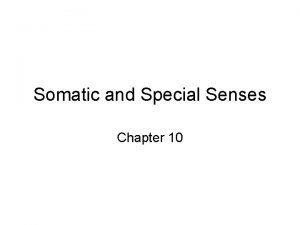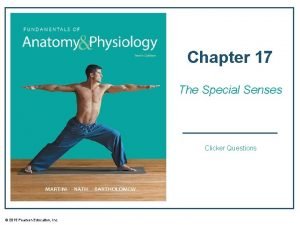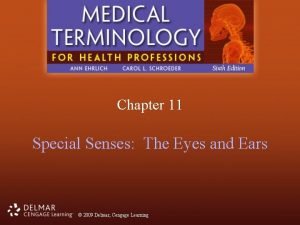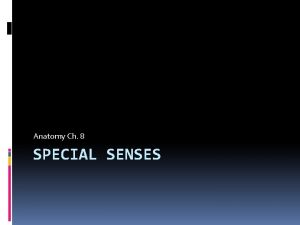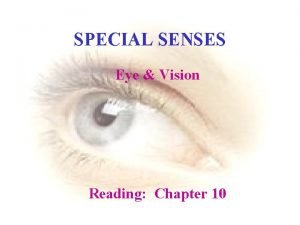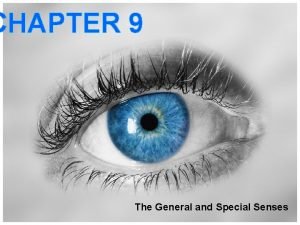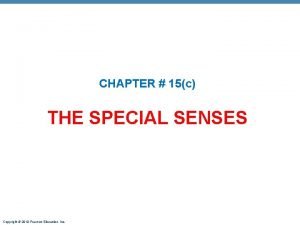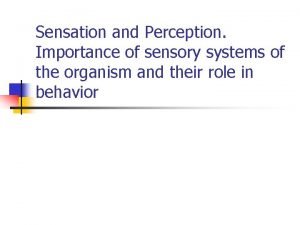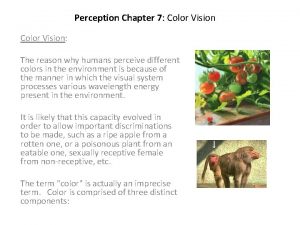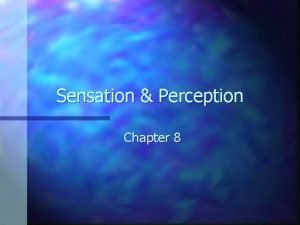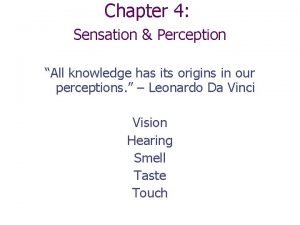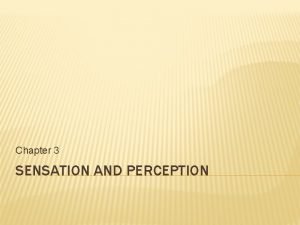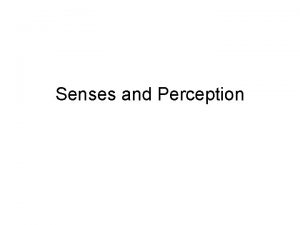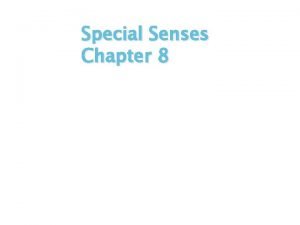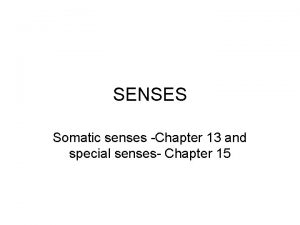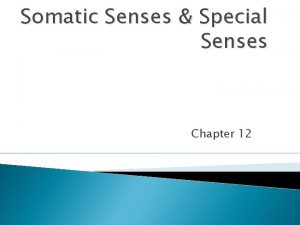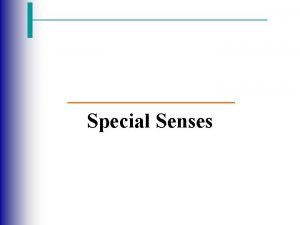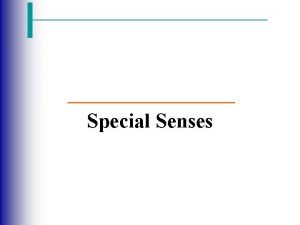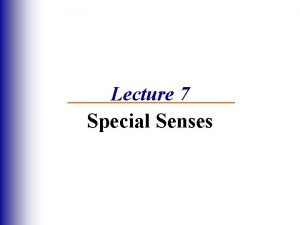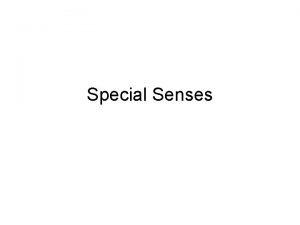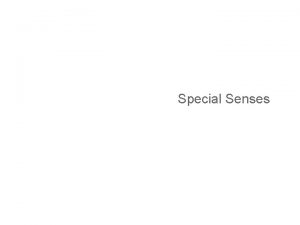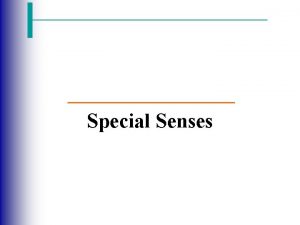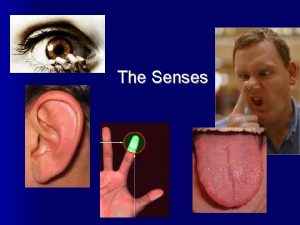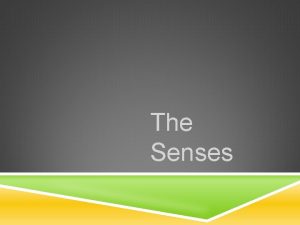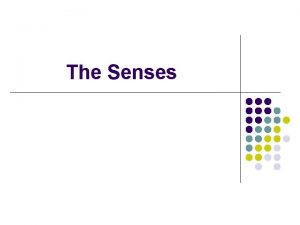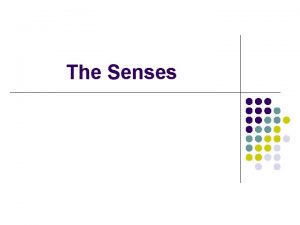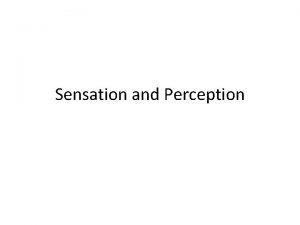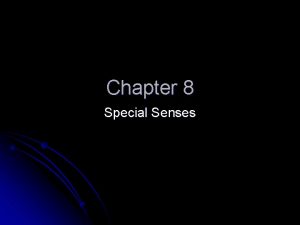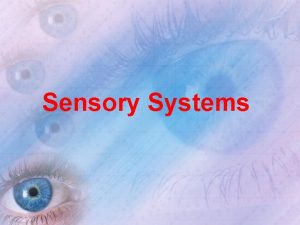Chapter 35 The Senses Sensory Perception Sensory Systems








































- Slides: 40

Chapter 35: The Senses Sensory Perception

Sensory Systems • The means by which organisms receive signals from the external world and internal environment • Many animals can sense stimuli that humans cannot

Sensory Receptors Convert the energy of a stimulus into action potentials Mechanoreceptors Chemoreceptors Thermoreceptors Osmoreceptors Pain receptors Photoreceptors


Sensory Pathways c Strectched muscle simulates a stretch receptor (the ending of a sensory neuron) that is adjacent to it. d Message travels from stimulated sensory neuron to motor neuron and interneuron in spinal cord sensory neuron interneuron in spinal cord motor neuron in spinal cord axon endings of motor neuron terminating on the same muscle e Message is sent back to the muscle, also to other interneurons in the brain. muscle spindle Fig. 35 -2 b, p. 601

Somatic Sensations • Touch • Pressure • Temperature • Pain • Motion • Position

Somatosensory Cortex Figure 35. 4 Page 602

Receptors in Skin • Free nerve ending • Ruffini ending • Pacinian corpuscle • Bulb of Krause • Meissner’s corpuscle Figure 35. 5 Page 603

Referred Pain • Sensations of pain from internal organs may be wrongly projected to part of the skin surface • Heart attack can be felt as pain in skin above the heart and along the left shoulder and arm

lungs, diaphragm heart stomach liver, gallbladder pancreas small intestine ovaries colon appendix urinary bladder kidney ureter Fig. 35 -6, p. 603

Taste • A special sense • Chemoreceptors • Five primary sensations: – sweet, sour, salty, bitter, and umami Figure 35. 8 Page 604

Smell • A special sense • Olfactory receptors • Receptor axons lead to olfactory lobe olfactory bulb receptor cell Figure 35. 7 Page 604

Balance and Equilibrium • In humans, organs of semicircular canals equilibrium are located in the inner ear utricle saccule • Vestibular apparatus vestibular apparatus Figure 35. 9 b Page 605

Acceleration-Deceleration Ø Moving in response to gravity, otoliths bend projections of hair cells and stimulate the endings of sensory neurons otoliths hair cell membrane vestibular nerve

Dynamic Equilibrium • Rotating head movements cause pressure waves that bend a gelatinous cupula and stimulate hair cells inside it cupula

Properties of Sound • Ear detects pressure waves • Amplitude of waves corresponds to perceived loudness • Frequency of waves (number per second) corresponds to perceived pitch

Sound Reception • Sound waves make the eardrum vibrate • Vibrations are transmitted to the bones of the middle ear • The stirrup transmits force to the oval window of the fluid-filled cochlea

scala vestibuli cochlear duct organ of Corti sensory neurons (to the auditory nerve) scala tympani Fig. 35 -11 d, p. 607

Fig. 35 -12 a, p. 607

Fig. 35 -12 b, p. 607

Vision • Sensitivity to light does not equal vision • Vision requires two components – Eyes – Capacity for image formation in the brain

Invertebrate Eyes Limpet ocellus ommatidium cuticle epidermis lens Compound eye of a deerfly sensory neuron Land snail eye Figures 35. 13 & 35. 14 Pages 608 & 609

Invertebrate Eyes Fig. 35 -13 d, p. 608

Invertebrate Eyes Fig. 35 -1, e, p. 608

vitreous body lens cornea retina optic tract Fig. 35 -15, p. 609

Human Eye sclera retina choroid iris lens pupil cornea aqueous humor fovea optic disk part of optic nerve ciliary muscle vitreous body Figure 35. 17 Page 610

Pattern of Stimulation • Light rays pass through lens and converge on retina at back of eye • The image that forms on the retina is upside down and reversed right to left compared with the stimulus • Brain accounts for this during processing

a Light rays from an object converge on the retina, form an inverted, reversed image. muscle contracted b When a ciliary muscle contracts, the lens bulges, bending the light rays from a close object so that they become focused on the retina. close object slack fibers muscle relaxed c When the muscle relaxes, the lens flattens, focusing light rays from a distant object on the retina. distant object taut fibers Fig. 35 -18, p. 611

Visual Accommodation • Adjustments of the lens • Ciliary muscle encircles lens • When this muscle relaxes, lens flattens, moves focal point farther back • When it contracts, lens bulges, moves focal point toward front of eye

Fig. 35 -16, p. 610

Organization of Retina • Photoreceptors lie at the back of the retina, in front of a pigmented epithelium • For light to reach the photoreceptors, it must pass layers of neurons involved in visual processing

cone cell stacked, pigmented membrane rod cell Fig. 35 -19, p. 612

Organization of Retina • Signals from photoreceptors are passed to bipolar sensory neurons, then to ganglion cells Figure 35. 20 Page 612

The Photoreceptors • Rods – Contain the pigment rhodopsin – Detect very dim light, changes in light intensity • Cones – Three kinds; detect red, blue, or green – Provide color sense and daytime vision

Receptive Fields signals to oscilloscope • Restricted areas that influence the activity of individual sensory neurons • Response of neuron to orientation of bar Figure 35. 21 Page 613 time (sec)

Fovea and Optic Nerve fovea start of an optic nerve in back of the eyeball Fig. 35 -22, p. 613

Retina to Brain optic retina nerve lateral geniculate nucleus visual cortex Figure 35. 23 Page 613

Disorders of the Eye (1) • Color blindness • Focusing problems – Nearsightedness and farsightedness • Eye diseases – Trachoma – Histoplasmosis – Herpes simplex infection

(focal point) distant object Nearsighted Vs Farsighted Fig. 35 -24 a, p. 614

(focal point) close object Nearsighted Vs Farsighted Fig. 35 -24 b, p. 614
 Distinguish between general senses and special senses.
Distinguish between general senses and special senses. General senses vs special senses
General senses vs special senses Chapter 10 somatic and special senses
Chapter 10 somatic and special senses Chapter 17 special senses answer key
Chapter 17 special senses answer key Learning exercises chapter 11 medical terminology
Learning exercises chapter 11 medical terminology Anatomy and physiology chapter 8 special senses
Anatomy and physiology chapter 8 special senses Eye anatomy
Eye anatomy Emmentropia
Emmentropia The general and special senses chapter 9
The general and special senses chapter 9 Olfactory receptor cells
Olfactory receptor cells Chapter 15 special senses
Chapter 15 special senses Sensory systems
Sensory systems Chapter 5 sensation and perception
Chapter 5 sensation and perception Chapter 7 vision and perception
Chapter 7 vision and perception Chapter 3 sensation and perception
Chapter 3 sensation and perception Chapter 6 sensation and perception
Chapter 6 sensation and perception Psychology chapter 4 sensation and perception
Psychology chapter 4 sensation and perception Kinesthetic sense
Kinesthetic sense Chapter 6 sensation and perception
Chapter 6 sensation and perception Chapter 7 managing risk vision and perception
Chapter 7 managing risk vision and perception Chapter 4 sensation and perception
Chapter 4 sensation and perception Chapter 3 sensation and perception
Chapter 3 sensation and perception Hình ảnh bộ gõ cơ thể búng tay
Hình ảnh bộ gõ cơ thể búng tay Bổ thể
Bổ thể Tỉ lệ cơ thể trẻ em
Tỉ lệ cơ thể trẻ em Chó sói
Chó sói Tư thế worm breton
Tư thế worm breton Alleluia hat len nguoi oi
Alleluia hat len nguoi oi Các môn thể thao bắt đầu bằng tiếng chạy
Các môn thể thao bắt đầu bằng tiếng chạy Thế nào là hệ số cao nhất
Thế nào là hệ số cao nhất Các châu lục và đại dương trên thế giới
Các châu lục và đại dương trên thế giới Cong thức tính động năng
Cong thức tính động năng Trời xanh đây là của chúng ta thể thơ
Trời xanh đây là của chúng ta thể thơ Mật thư anh em như thể tay chân
Mật thư anh em như thể tay chân 101012 bằng
101012 bằng độ dài liên kết
độ dài liên kết Các châu lục và đại dương trên thế giới
Các châu lục và đại dương trên thế giới Thể thơ truyền thống
Thể thơ truyền thống Quá trình desamine hóa có thể tạo ra
Quá trình desamine hóa có thể tạo ra Một số thể thơ truyền thống
Một số thể thơ truyền thống


